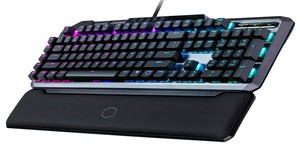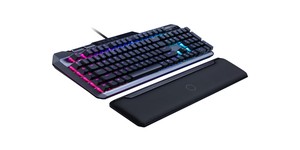
A start-up company is aiming to turn the humble keyboard on its head by adding in a feature previously exclusive to joysticks and gamepads: analogue inputs.
The inputs on modern gamepads operate in an analogue rather than digital fashion: the triggers and thumbsticks can report a range of motion rather than a binary on-off, allowing the player to creep forward or turn slowly before bursting into a run simply. While few would disagree that a keyboard and mouse setup provides more accurate aiming and quicker response times, it does come with a trade-off: although the mouse's input is analogue, the keyboard keys are resolutely digital.
A start-up company calling itself Wooting has turned to Kickstarter to crowd-fund the production of what it is claiming is the first fully-functional analogue gaming keyboard. Based on customised 'Flaretech' switches designed to mimic the popular Cherry MX, each key is capable of operating in a traditional digital mode - in which its creators claim it is indistinguishable from a normal mechanical keyboard - or in analogue mode, during which it reports a value back to the operating system depending on how far through its travel the key is pushed.
Having analogue hardware is one thing, but if your software doesn't support it you're stuck. Wooting's answer to this is to build the keyboard using a multi-mode input: as well as operating as a standard USB keyboard, the device can be switched into DirectInput and Xinput modes during which time it appears to the OS as a generic gamepad or Xbox controller. Any game supporting analogue input from a gamepad is thus supported by the Wooting One, with the exception of a handful of titles which - for reasons of their own - disable the keyboard and mouse when a gamepad is detected.
The company has already hit its modest €30,000 funding goal with all early-bird pledges claimed; anyone looking to get in on the action now will be paying the full price of €139, for which they will receive the keyboard with Red (linear) or Blue (clicky tactile) switches, detachable braided USB cable, keycap and switch pulling tool, four additional switches for testing purposes, and two spare switches and a handful of screws for the keyboard.
More information is available on the Kickstarter campaign page.
The inputs on modern gamepads operate in an analogue rather than digital fashion: the triggers and thumbsticks can report a range of motion rather than a binary on-off, allowing the player to creep forward or turn slowly before bursting into a run simply. While few would disagree that a keyboard and mouse setup provides more accurate aiming and quicker response times, it does come with a trade-off: although the mouse's input is analogue, the keyboard keys are resolutely digital.
A start-up company calling itself Wooting has turned to Kickstarter to crowd-fund the production of what it is claiming is the first fully-functional analogue gaming keyboard. Based on customised 'Flaretech' switches designed to mimic the popular Cherry MX, each key is capable of operating in a traditional digital mode - in which its creators claim it is indistinguishable from a normal mechanical keyboard - or in analogue mode, during which it reports a value back to the operating system depending on how far through its travel the key is pushed.
Having analogue hardware is one thing, but if your software doesn't support it you're stuck. Wooting's answer to this is to build the keyboard using a multi-mode input: as well as operating as a standard USB keyboard, the device can be switched into DirectInput and Xinput modes during which time it appears to the OS as a generic gamepad or Xbox controller. Any game supporting analogue input from a gamepad is thus supported by the Wooting One, with the exception of a handful of titles which - for reasons of their own - disable the keyboard and mouse when a gamepad is detected.
The company has already hit its modest €30,000 funding goal with all early-bird pledges claimed; anyone looking to get in on the action now will be paying the full price of €139, for which they will receive the keyboard with Red (linear) or Blue (clicky tactile) switches, detachable braided USB cable, keycap and switch pulling tool, four additional switches for testing purposes, and two spare switches and a handful of screws for the keyboard.
More information is available on the Kickstarter campaign page.

MSI MPG Velox 100R Chassis Review
October 14 2021 | 15:04








Want to comment? Please log in.